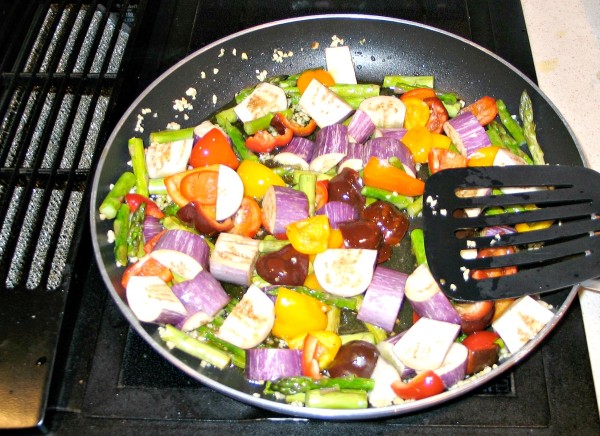
I’m “lucky” that my kids, for the most part, are rather healthy eaters. It comes in waves, I’ve learned, from toddlers exploring their world (which ironically, sometimes means eating fewer rather than more foods) to the expanding palettes of middle schoolers to teenagers carving out their own ways in the world (which if yours are anything like mine, things have come back to “I’m not going to eat that. Period.”).
Oh the joy of teenagers.
But overall, I can’t complain. My kids will try pretty much anything and if we’re in mixed company I can rely on them to be polite and find something they’ll enjoy and I know they’ll be pleasant about it. That’s a win in my book.
This, my friends, didn’t just happen, I was not blessed with kids who just love different foods. Far from it.
This took work.
But it was all worth it, you know? My kids are older now and like I said, they’re expressing their preferences with more determination and honestly I see this phase of my life as the place where I back off and let them make a lot of their own decisions.
In looking back, I can recall a lot of different things we’ve done along the way to get to where we are today. These are some of the key points that come to mind that I’ve tried to follow.
1) Don’t judge your kids’ eating habits (at least not out loud in front of them).
Just as you wouldn’t describe your child as “clumsy” or “strong-willed” or “tantrum-prone” in front of them, don’t describe them as “picky eaters” either (even though you may darn well feel that way). Calling your child a picky eater immediately puts you at odds with him – and how motivated are you to change when you already know you’re not measuring up to someone’s expectations? Hmmmm?
Play it cool - you’re not doing yourself any favors by letting your kids know you have a stake in this.
2) Establish your family rules and boundaries and stick to them.
Everyone has different rules that apply to mealtimes and that’s cool - come up with the rules that work for you! But when establishing those rules, be sure to keep your end goal in mind – what do you hope to establish as the daily habits for your kids? If you want to expand their palettes and you want them to reliably try at least a little bit of something (particularly when you’re away from home), then you’ll have to make it your rule that they have to have more than just a taste of a new food. It takes time for anyone, but especially kids, to accept lots of different foods.
Often a new food will taste strange and unfamiliar and maybe even yucky the first time around – so if you want them to enjoy a range of foods, they’ll need to have more than just a taste at any given meal. Decide what your minimum serving is and expect your kids to eat it. It doesn’t have to be a large amount – just be consistent with enforcing it. Don’t be unreasonable with the amount – make it small enough for them to reasonably finish if they don’t immediately like it. But do expect them to finish it, and serve it again before too long.
Consistency, consistency, consistency – day in and day out.
3) Offer reasonable options whenever possible.
A lot of kids don’t like cooked vegetables (and I can’t say I really blame them. Of course I eat cooked vegetables, but given the choice between a raw carrot or a cooked carrot? Or a raw pepper and a cooked pepper? Or even raw peas or cooked peas? I’ll take the raw any day!). Even now when we have green beans I have to stop Caton from eating them out of the steamer basket because he’ll eat so many before they’re cooked that we won’t have enough left for the rest of us.
When my kids were toddlers I’d make a cooked vegetable with dinner and also serve a big communal bowl of raw vegetables. For those who didn’t mind cooked, I’d place a full serving on their plate. For those who preferred raw, I’d put a very small serving of cooked vegetables on their plate and expect them to take the rest from the raw bowl.
Plus, let’s face it, it’s pretty easy to slice up a red pepper, grab some carrot sticks and chop a few stalks of broccoli and leave it at that. Why go to the trouble of cooking when your kids prefer raw? Take the easy way out! (I still serve raw spinach WAY more often than cooked. It’s easier, it’s healthier, and the kids enjoy it more so I call that a 3-way win).
I have one kid who actually preferred the veggies frozen for a while. Weird? Yeah. But we went with it because, well, why not?
Also if you’re introducing something really new or something that’s still pretty unfamiliar, pair it with something that’s a moderate favorite. If your kids love corn on the cob and you’re trying to get them to like cauliflower, don’t serve both in the same meal – the cauliflower can never measure up to the corn in their eyes! Go with something they’re familiar with, but maybe don’t love yet. Then the two foods sort of become a lesser-of-two-evils choice and at least one of the foods takes the preferred position.
Sometimes you’ve got to be a little crafty!
4) Give your kids a chance to call the shots.
Let your kids help with the menu plan. Personally I plan out my meals a week in advance for two reasons:
1) Although I enjoy grocery shopping, I hate having to make quick trips during the week - it seems to take so much time to just pick up a couple of things! So I try to plan the week’s meals and shop all at once for them (try being the operative word here – of course it doesn’t always work out that way, but more often than not it does).
2) I really stink at deciding meals on the fly. My afternoons are usually spent running around with the kids, doing errands, or working on my own projects when we’re at home and I hate having to shift my focus to what I need to do to have dinner ready in a few hours. By making the menu on the weekend, I can plan around the afternoon and evening schedule and I know exactly how much time I’m going to need to cook, and I can have anything from the freezer defrosted by the time I need it.
Ask your kids what they’d like for lunch or dinner and try to accommodate their requests. Maybe have one day a week where they get to choose the whole menu and give them lots of freedom! Remember that a balanced diet is put together over the course of a few days, not a single meal. If you need to, give them some guidelines – for example, they have to choose a protein, two vegetables and a fruit. Or you pick the meat or main dish and they choose the side dishes. Or vice versa, you choose the vegetables and sides and they get to choose the protein.
Kids are much more inclined to eat what they’ve chosen, even if you give them the options to select from.
5) Show your kids where fresh food comes from.
Late spring, summer and early fall are all great times to visit local pick-your-own fields. Most areas have berries in the summer and apples in the fall, but some regions have lots of different things you can pick yourself. Around here we have the usual strawberries, blueberries, apples, peaches, etc. but at some farms you can pick your own potatoes, beets, peas, spinach, basil, etc. It’s always an adventure seeing exactly how these things grow and finding out first-hand how something gets from the field to our table.
If you’re not seasoned pickers and this is your first time heading out, keep it simple. Chances are you won’t get enough peas for a whole meal, but that’s OK. That’s part of the learning process. When you open a bag of frozen peas and pour out six servings into the steamer, your kids will know exactly how much work it was to get enough peas for six people. Peas become something familiar that they understand, because they’ve picked them with their own hands. They may have even eaten them right off the vine. Even better.
Take the time to show your kids exactly how the earth provides their food – familiarity breeds a much more open mind!

I hope these five tips give you some fresh ideas for rethinking the way you approach meal time in your home. On Friday I’ll be posting one of my very favorite farm-fresh recipes, so check back for that. And next Tuesday I’ll have more fun and creative ways to get your kids involved in the kitchen.
Meanwhile, what are some of your family rules or traditions regarding kids and food? Please share in the comments below!

